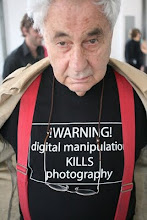
Kryn Taconis (Rotterdam, 1918) was the only Dutchman who was member of the legendary Magnum photo agency.
 He made his first photographs during the Second World War, in the course of producing false documents for the resistance. He also worked for the Underground Camera, a group of Dutch photographers who secretly recorded the German occupation.
He made his first photographs during the Second World War, in the course of producing false documents for the resistance. He also worked for the Underground Camera, a group of Dutch photographers who secretly recorded the German occupation.
After the war Taconis became a freelance photographer and correspondent for Time-Life in the Benelux. After joining Magnum in 1950, he want to Algeria in 1957 to photograph the activities of the FLN (Front de Liberation National) there. For two weeks the recorded the guerrilla war that the Algerian resistance movement conducted from the woods against the French colonialists.
 The FLN fought with weapons captured from the French. Good contacts in the countryside provided for sufficient food and clothing. During the time he was with them, the resistance group attacked a French convoy. According to the French radio eight guerrillas were killed in the action, while in reality no one was even wounded.
The FLN fought with weapons captured from the French. Good contacts in the countryside provided for sufficient food and clothing. During the time he was with them, the resistance group attacked a French convoy. According to the French radio eight guerrillas were killed in the action, while in reality no one was even wounded.
Taconis continued as a member of Magnum until 1960. The year before that he had emigrated to Canada, where he remained a freelance photographer for Canadian magazines. In the 1960s he also produced and directed a number of films for the Canadian government.
 He made his first photographs during the Second World War, in the course of producing false documents for the resistance. He also worked for the Underground Camera, a group of Dutch photographers who secretly recorded the German occupation.
He made his first photographs during the Second World War, in the course of producing false documents for the resistance. He also worked for the Underground Camera, a group of Dutch photographers who secretly recorded the German occupation.After the war Taconis became a freelance photographer and correspondent for Time-Life in the Benelux. After joining Magnum in 1950, he want to Algeria in 1957 to photograph the activities of the FLN (Front de Liberation National) there. For two weeks the recorded the guerrilla war that the Algerian resistance movement conducted from the woods against the French colonialists.
 The FLN fought with weapons captured from the French. Good contacts in the countryside provided for sufficient food and clothing. During the time he was with them, the resistance group attacked a French convoy. According to the French radio eight guerrillas were killed in the action, while in reality no one was even wounded.
The FLN fought with weapons captured from the French. Good contacts in the countryside provided for sufficient food and clothing. During the time he was with them, the resistance group attacked a French convoy. According to the French radio eight guerrillas were killed in the action, while in reality no one was even wounded.Taconis continued as a member of Magnum until 1960. The year before that he had emigrated to Canada, where he remained a freelance photographer for Canadian magazines. In the 1960s he also produced and directed a number of films for the Canadian government.
 For fear of French reprisals, Kryn Taconis's trip to Algeria was clandestine. For the same reason the photographs he made there were only published after his death in 1979.
For fear of French reprisals, Kryn Taconis's trip to Algeria was clandestine. For the same reason the photographs he made there were only published after his death in 1979. Read more ...






















